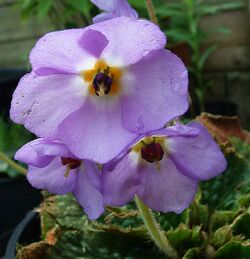Biology:Ramonda serbica
From HandWiki
Short description: Species of flowering plant
| Ramonda serbica | |
|---|---|

| |
| Scientific classification | |
| Kingdom: | Plantae |
| Clade: | Tracheophytes |
| Clade: | Angiosperms |
| Clade: | Eudicots |
| Clade: | Asterids |
| Order: | Lamiales |
| Family: | Gesneriaceae |
| Genus: | Ramonda |
| Species: | R. serbica
|
| Binomial name | |
| Ramonda serbica Pančić
| |
| Synonyms[1] | |
| |
Ramonda serbica, also known as Serbian ramonda and Serbian phoenix flower, is a species in the family Gesneriaceae. It is one of the few European representatives of this family, found in Albania, Bulgaria, Greece, North Macedonia and Serbia. It is typically found in cool, damp, shaded environments, primarily on steep, north-facing limestone foundations. The flower was discovered by Serbian botanist Josif Pančić in 1874 near Niš.[2] It is known for its ability to be revived when watered, even when fully dehydrated, also known as a Desiccation plant.[3] In Serbia it is used as a symbol of Armistice Day in World War I.[4]
References
- ↑ The Plant List: A Working List of All Plant Species, http://www.theplantlist.org/tpl1.1/record/kew-2422128, retrieved 3 October 2015
- ↑ About Serbian Ramonda on this website pancic.bio.bg.ac.rs
- ↑ Yuki Nakamura and Yonghua Li-Beisson (Editors)ISBN 9783319259772, Springer, p. 185, at Google Books
- ↑ "Natalie's Ramonda, a Symbol of Armistice Day in Great War" (in en-US). 2014-07-13. http://www.dijaspora.gov.rs/en/natalie-s-ramonda-symbol-armistice-day-great-war/.
Bibliography
- Mike F. Quartacci, Olivera Glisic, Branka Stevanovic, and Flavia Navari-Izzo. Plasma membrane lipids in the resurrection plant Ramonda serbica following dehydration and rehydration. J. Exp. Bot 2001.53:2159-2166.
- Rix, E.M. & Webb, D.A. 1972. Ramonda L.C.M. Richard. - In: Tutin, T.G., Heywood, V.H., Burges, N.A., Moore, D.M., Valentine, D.H., Walters, S.M. & Webb, D.A. Flora Europaea vol. 3. Pp. Cambridge University Press, Cambridge.
- Markova, M. 1995. Ramonda. - In: Kozhuharov, S. Flora of People's Republic of Bulgaria. Vol. 10. pp. 288–289. Bulgarian Academy of Sciences Publishing House, Sofia. (In Bulgarian)
- Petrova, A. & Vladimirov, V. 2010. Balkan endemics in the Bulgarian flora. - Phytologia Balcanica 16(2): 293–311.
- Rakić, T., Gajić, G., Lazarević, M., & Stevanović, B. (2015). Effects of different light intensities, CO2 concentrations, temperatures and drought stress on photosynthetic activity in two paleoendemic resurrection plant species Ramonda Serbica and R. Nathaliae. Environmental and Experimental Botany, 109, 63–72
Wikidata ☰ Q2272219 entry
 |

